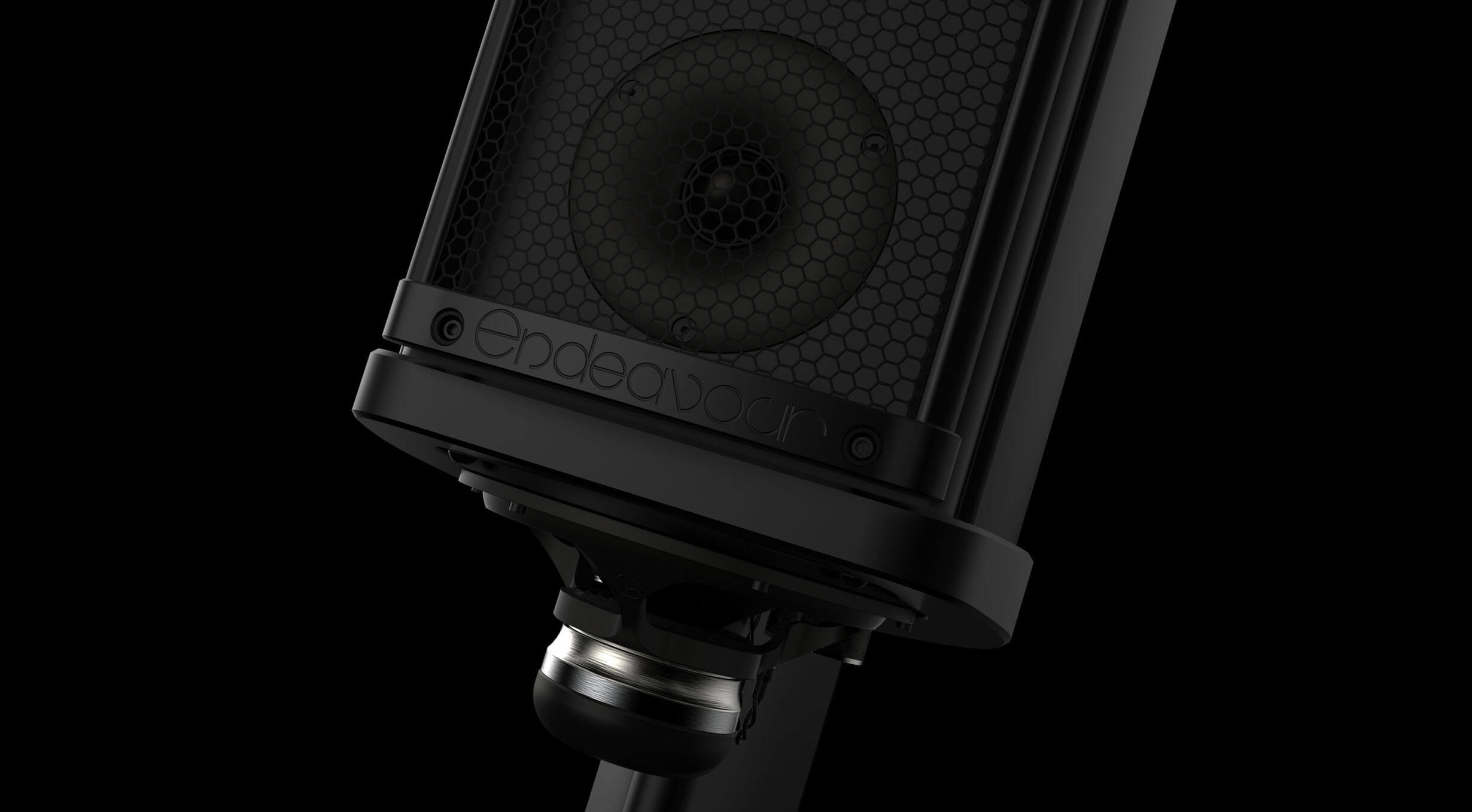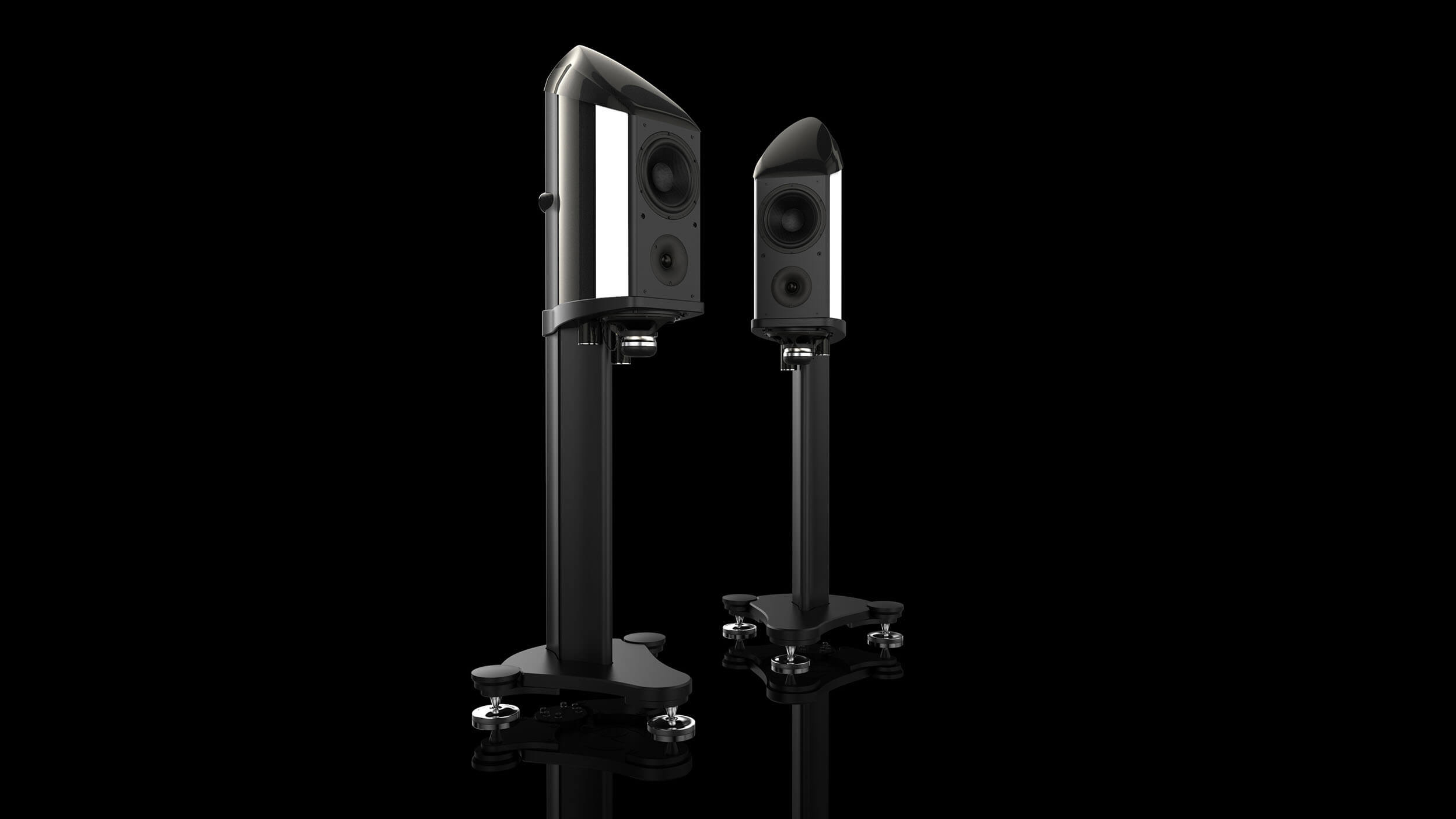Endeavour P1 Press Kit
GEOMETRY SERIES
Since its foundation, Wilson Benesch has invested heavily in ambitious research and development projects in the fields of materials science and manufacturing. The Endeavour exploits more than two-decades of work, to incorporate a multitude of cutting edge Wilson Benesch technologies.
From the very latest new technology, the Carbon Nanotech Enclosure, to the Isobaric Drive System, the A.C.T. Monocoque and a number of highly engineered, geometrically optimised carbon fibre and alloy components, the Endeavour is a masterpiece of engineering.
Featuring the very latest Wilson Benesch Drive Technology, the Endeavour is capable of delivering wide bandwidth sound from 38Hz to 30kHz. A dedicated Tactic II midrange drive unit sits inside the Carbon Nanotech Enclosure, with a clamshell formation Tactic II Isobaric System taking care of the lightning-fast bass to create a perfectly integrated low-mid range response. At the centre, the Semisphere Silk-Carbon Hybrid dome Tweeter delivers a perfectly tonally balanced and natural sounding high frequency band.
Through expert design and craftsmanship, advanced materials technology has been combined with geometry in every component to created a stand mount loudspeaker design with no compromise. The Endeavour faithfully reproduces the musical ensemble, as though the performers were there in the room before you.
Technology
CARBON FIBRE TOP

Following the same principles of the A.C.T. monocoque, the carbon fibre top in the Endeavour and Cardinal have been designed firstly to damp internal cabinet born resonance and secondly to negate standing waves interacting with the loudspeaker surface. The overall effect is a vastly improved signal-to-noise ratio. The Endeavour top, along with the Cardinal top, is perhaps one of the most complex carbon fibre forms ever created by Wilson Benesch. Developed using industry standard 3D CAD / CAM software, the moulding tool was milled from one solid block of aluminium to tight a high degree of accuracy. Subsequently the resin transfer moulding technique perfected in the A.C.T. monocoque is employed to create a beautifully sculptural carbon fibre form with no compromises in terms of its function.
A.C.T. MONOCOQUE

A sophisticated three-layer composite structure comprised of carbon fibre, high compression blast core and glass fibre. In terms of energy damping and therefore signal-to-noise ratio, the A.C.T. Monocoque exceeds with consummate ease the materials traditionally used in loudspeaker design. Wilson Benesch have optimised the A.C.T. Monocoque by creating a curved form. The geometric form of the cabinet negates standing waves by reducing the number of flat surfaces on the loudspeaker surface. Thus any sound waves interacting with the surface of the A.C.T. Monocoque are diffracted across a wide angle and thus diminished. As a result such distortions are impossible for the ear to detect, allowing the loudspeaker to disappear within the listening space; stealth like the loudspeaker creates a wide open and life like soundstage.
VARIABLE PORTING

The port tubes in the Endeavour evolve a step beyond those found in the Vertex and the Discovery II. Here the material of choice is carbon fibre, an aesthetic cue that adds to the luxurious, high technology dialogue of the Endeavour design. Wilson Benesch adds flexibility to the Endeavour by enabling the owner to adjust the bass output. Threaded caps can be screwed into the end of the port tube in order to seal either one or both of the ports. When combined with the Torus, this technique can be applied to reduce the load on the Endeavour’s Isobaric Drive System, improving dynamics and integration with the midrange.
CARBON NANOTECH ENCLOSURE

The curved geometry of the loudspeaker cabinet is expressed in its ultimate form in the world's first Carbon Nanotech (carbon nanotubes dispersed within the resin matrix) speaker enclosure. The Champagne bottle shape is no coincidence providing as it does the near ideal form for controlling the narrow bandwidth of the mid range Tactic II drive unit. This elegant solution not only provides the ideal enclosure for the mid range it also frees the rest of the cabinet to enable the isobaric to function optimally with the largest possible air volume.
KINEMATIC LOCATION

First introduced in the kinematic bearing design in the Wilson Benesch A.C.T. One Tonearm in 1991, the bearing was designed on the principles of kinematic coupling. The fundamental principle of kinematic coupling is to selectively eliminate each one or all of the six degrees of mechanical freedom that any physical body has. In the Endeavour, three 28mm steel threads, each tipped with a 12.5mm steel ball, meet with three 12.5mm chrome steel balls, held captive inside the floor protector. This creates a triangulated structure, with a contact point of less than 1mm2. This provides high-integrity, stable location of the loudspeaker.
ISOBARIC DRIVE SYSTEM

On the underside of the Endeavour, two Tactic II drive units combine to create an Isobaric Drive System. The Isobaric Drive is responsible for reproducing incredibly tight and controlled bass response that integrates perfectly with the midrange Tactic II drive unit. The Isobaric Drive System incorporates two lightning fast, highly dynamic bass woofers which create the full range of bass notes up to 25Hz. Although the Isobaric Drive System operates at a much higher load than the midrange units, the load is shared by two drive units working together, allowing the Isobaric Drive System to remain perfectly integrated with the midrange units. This degree of speed and dynamics cannot be achieved with conventional large woofer designs.
TACTIC II DRIVER

There are no transient delays in nature – when a singer sings, or a drummer strikes you hear the sound almost instantly. But when a drive unit tries to replicate this sound from a recording, the transient response time, although minute, is easily detected by the ear and the brain. When designing a drive unit, it is critical to reduce the transient response time as much as possible. Any delay, informs the brain that what is being listened to is in fact a recording and not a real human voice or instrument. Wilson Benesch developed the original Tactic drive unit and subsequent Tactic II drive unit around this philosophy. We employed a light cone material, with phenomenally powerful NdFeB Rare Earth Magnets, with a highly evolved motor geometry to optimise flux. The result was a dynamic drive unit that could excurse through the in and out range of its movement during use very quickly and under a high degree of control. The original Tactic design was described as “lightning fast” in the first test reviews.
SEMISPHERE TWEETER

Designed and manufactured in house, the Semisphere has been developed to match the Tactic II Drive Unit, creating seamless integration across the mid-high frequency band. At the heart of the Semisphere is the Silk-Carbon Hybrid Dome. The hybrid dome tweeter, retains the natural sound of a soft dome tweeter, remaining free from sibilance. However the addition of carbon fibre through a proprietary technique, allows the Semisphere to remain flat through the frequency range to 30kHz. Built around the dome is a combination of highly engineered components, which have been precision machined in house at Wilson Benesch. At the front a curved front plate creates the ideal launch surface for high frequency sound. To the rear of this is a complex motor front and rear plate that hold a ring of six powerful rare earth magnets. The design allows optimal venting and allows the Semisphere to remain cool during extended use.
Specification
| DRIVERS | 1 x 25mm ( 1") Wilson Benesch Semisphere tweeter 1 x 170mm ( 7") Wilson Benesch Tactic II mid-range drive unit 2 x 170mm ( 7") Wilson Benesch Tactic II Isobaric bass drive units |
| CONSTRUCTION | Poly-alloy hybrid construction High performance carbon composite A.C.T. monocoque Carbon-Nanotech mid-range enclosure with carbon fibre port Isobaric enclosure with dual carbon fibre ports Variable Isobaric enclosure porting achieved by airflow adapters 4kg precision machined Isobaric drive bass board |
| PERFORMANCE | 2.5-way stand mounted monitor Impedance: 6Ω nominal / 4Ω minimal Sensitivity: 89dB at 1 metre on-axis, 2.83V Input Frequency response: 38Hz - 30kHz +/- 2dB on-axis Minimum amplification power recommendation: 100 W / channel Crossover frequency: 500Hz / 5kHz |
| DIMENSIONS | Height: 1475mm ( 58") Width: 245mm ( 9.6") Depth: 435mm ( 17.1") Volume: 22L Weight per channel: 70kg (154 lbs) |
| FINISHES | erospace silk black baffle, spine and foot High gloss satin weave carbon fibre cabinet High gloss carbon fibre top |
Featured
- Each Endeavour is equipped with very latest, cutting edge Wilson Benesch’s drive technologies that deliver wide bandwidth sound from 38Hz to 30Khz. At the heart of the Endeavour powerhouse are six Tactic II drivers and two Semisphere tweeters per pair.
- Since its foundation, Wilson Benesch has invested heavily in ambitious R&D projects in the fields of advanced materials science and manufacturing technology.
- Two downwards-firing Tactic II drive units form the Endeavour’s Isobaric Drive. Unlike the Cardinal, this is deployed in a clamshell configuration.
- The Endeavour places the high energy Isobaric Drive within inches of the mid-range and tweeter drive units.
Awards

Outstanding Elite Overall Performance Super AV Awards 2014

Best Performance of the Year 2016 Audio Arts Awards 2016








